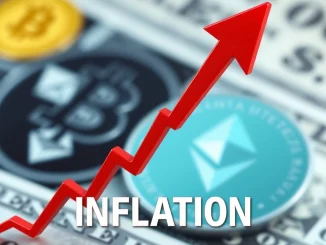
Why should cryptocurrency investors pay attention to seemingly distant economic reports? Because crucial economic data like the U.S. core PCE price index can significantly influence market sentiment and liquidity, directly impacting assets like Bitcoin and Ethereum. The latest report offers insights into the ongoing inflation picture.
Understanding the Latest April Inflation Report
The U.S. Bureau of Economic Analysis (BEA) recently released key inflation data for April. According to their official figures, the core Personal Consumption Expenditures (PCE) price index saw a modest increase of just 0.1% from the previous month. This figure is particularly noteworthy because it precisely matched the expectations of market analysts.
What does this mean? When economic reports align with forecasts, it often signals a period of relative stability, avoiding the volatility that can come from major surprises. The 0.1% monthly rise in the PCE price index suggests that underlying inflationary pressures remained contained in April, at least according to this specific metric.
Why the U.S. Core PCE Matters So Much
The core PCE price index isn’t just another statistic; it’s the Federal Reserve’s preferred gauge for tracking inflation. Unlike the Consumer Price Index (CPI), PCE covers a broader range of goods and services and accounts for shifts in consumer spending habits. The ‘core’ version excludes volatile food and energy prices, providing a clearer picture of underlying price trends.
The Fed uses this data point extensively when making decisions about monetary policy, specifically regarding interest rates. Their mandate includes maintaining price stability, and the core PCE is a primary tool they use to assess their progress towards their inflation target (typically 2%).
Decoding the Economic Data: What 0.1% Tells Us
A 0.1% monthly increase is considered quite low in the context of recent inflationary periods. While we don’t have the year-over-year figure mentioned in the original snippet, a small monthly gain like this, especially when meeting expectations, is generally interpreted positively by markets hoping for potential future interest rate cuts.
Here’s a quick breakdown of why this specific number is important:
- Meeting Expectations: This avoids negative shocks. Markets had priced in a 0.1% rise, so the actual number didn’t necessitate a sudden repricing of assets or interest rate probabilities based on this single report.
- Low Monthly Gain: A 0.1% rise is significantly lower than what was seen during the peak of inflation. It suggests progress towards the Fed’s 2% annual target, although the path remains bumpy.
- Core Focus: By excluding food and energy, the core number focuses on stickier inflation components, which are often harder to bring down. A low core number is a good sign for the Fed.
Potential Implications for the Crypto Market
So, how does this seemingly small number affect the world of digital assets? Here’s the connection:
Inflation Data and Interest Rates: Lower, stable inflation data gives the Federal Reserve more flexibility to consider cutting interest rates in the future. Higher interest rates typically make riskier assets like cryptocurrencies less attractive compared to safer, yield-bearing investments like bonds or savings accounts.
Liquidity: Lower interest rates generally increase overall market liquidity, which can flow into risk assets, including crypto. When borrowing costs are low, investors are more likely to seek higher returns in potentially volatile markets.
Market Sentiment: Data that aligns with expectations and shows progress on inflation can contribute to a more stable and positive market sentiment, which can be beneficial for crypto prices. Surprising high inflation data, conversely, often leads to market downturns as fears of aggressive rate hikes increase.
In the short term, the fact that the U.S. core PCE met expectations likely contributed to avoiding any immediate negative reaction in risk asset markets, including crypto. It reinforces the narrative that inflation is gradually cooling, keeping hopes for potential future rate cuts alive, even if the timing remains uncertain.
Looking Ahead: What Comes Next?
While the April PCE price index report is a positive data point, it’s just one piece of the puzzle. The Federal Reserve considers a wide range of economic data, including employment figures, GDP growth, and other inflation measures, when making policy decisions.
Future reports will continue to be scrutinized for signs of whether inflation is sustainably moving towards the Fed’s target. The market’s focus will now shift to upcoming economic releases and statements from Fed officials to gauge the likely path of interest rates in the coming months. The crypto market will continue to react to these broader macroeconomic signals.
Conclusion: Stability in April’s Inflation Data
The report showing the U.S. core PCE price index rising just 0.1% in April, exactly as analysts predicted, provides a degree of stability regarding the inflation outlook. This key piece of inflation data, the Fed’s preferred metric, suggests that underlying price pressures remained contained during the month. For the crypto market, data that meets expectations and indicates cooling inflation is generally supportive, as it keeps the possibility of future interest rate adjustments open and avoids negative economic surprises that could dampen market sentiment and liquidity. Investors will remain watchful of subsequent economic reports to refine their outlook.



